Not only is a breakaway cable an essential, life-saving piece of kit when towing a caravan (or any other braked trailer), it’s also a legal requirement to have one fitted to your outfit.
It’s the one thing that will apply the caravan brakes should your tourer become detached from your tow car when towing. It’s therefore really important to check your breakaway cable has been correctly fitted before every caravanning trip to avoid a serious accident or injury, as detachments are more common than you might think!
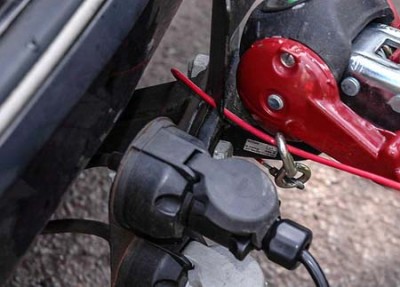
Here at Caravan Guard, we’ve dealt with detachment claims where the breakaway cable has failed and on roadside checks breakaway cables are regularly are incorrectly attached to the tow bar or not at all!
In this video, Leisure Vehicles Officer and caravan safety expert Tim Booth goes through how important the breakaway cable is when caravanning; the different types of breakaway cables available, and how to attach them to different types of towbars and the importance of looking after your caravan’s breakaway cable.
Why do you need a breakaway cable?
Legally, if you’re towing a trailer over 750kg it needs to have a breakaway cable to activate the braking system in the event of a detachment. A caravan breakaway cable is designed to take a two tonne strain.
Different types of breakaway cable
There’s a new standard for 2018 caravans – all breakaway cables will have the carabiner clip, with a view to helping users in the correct fitting of this caravanning safety device. This type of breakaway cable can either clip to a dedicated mounting point on the towbar – or pass around the towbar assembly and clip back onto the cable.
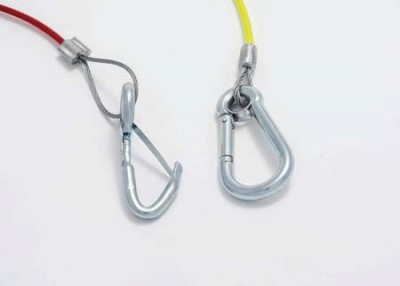
The other type of breakaway cable is a spring clip, which always has to go back onto the cable and cannot be connected to a fixed mounting point.
This is because the ‘tug’ on the cable can cause the clip to stretch rather than activate the handbrake, whereas with the cable ‘clipped’ around the whole tow bar assembly the cable will achieve its potential of pulling the handbrake on.
How does the breakaway cable work?
A caravan breakaway cable is designed to snap after it’s pulled on the caravan’s handbrake and brings your caravan to a standstill in the event of a detachment, leaving it in a safe position, so it doesn’t cross or leave the road or carriageway and cause injury to other road users, pedestrians or nearby properties.
When should I connect the breakaway cable when I’m hitching up?
When hitching up it’s important not to lose control of your caravan or trailer tent so if YOU connect your breakaway cable to your towing vehicle before connecting the electrics etc, it’s unlikely the caravan or trailer will roll away. If you’re hitching up on a slope it’s essential that you make that connection before releasing the handbrake.
What’s the best practice when connecting the breakaway cable?
It’s best practice to make sure the breakaway cable is fitted to the designated mounting point or around the framework of the tow bar and to also make sure that it’s in a straight line so it can work most effectively.
Also make sure the cable goes through the guide on your caravan chassis as this helps to keep it in a straight line so it can apply the handbrake if it’s pulled with force. Also make sure that the cable isn’t or can’t be entangled with the electrical cable and/or any external stabiliser in place.
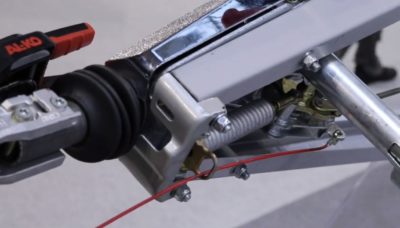
The breakaway cable should be long enough so that it doesn’t attempt to apply the brakes when towing, particularly around corners, but not too long or slack that it drags on the road or becomes wrapped around some part of the front of the caravan when in use.
Looking after your caravan’s breakaway cable
The breakaway cable is an important part of the braking system of your caravan therefore it’s essential that it’s properly maintained. Before your caravanning trips, always check the cable for any signs of wear and tear. Be careful when running your fingers over the cable as any damage to the plastic might expose the wire, which will be sharp.
Also, check the connection where the carabiner or spring clip is attached. If there are any loose wires then you need to replace the cable. When replacing the cable make sure it’s as similar as possible to the original. Look for the thickness of the cable and the protective coating to make sure it’s going to effectively take the strain of your caravan and apply the brakes.
Fitting a breakaway cable to different tow bars
To make sure a breakaway cable does its job correctly it needs to have the correct connection to your tow car – otherwise it will fail and not apply the caravan brakes.
- A detachable tow bar with no dedicated connection point – The breakaway cable must be looped around the tow ball and clipped back on itself when using a cable with a carabiner or spring clip.
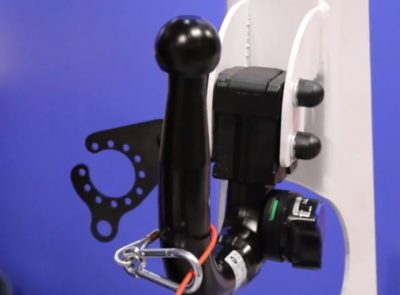
- A bolted tow bar with no mounting point – Pass the breakaway cable through the tow bar assembly and over the top before looping the carabiner or spring clip back onto the cable, so the cable is fastened to the tow bar assembly and tow car’s chassis.
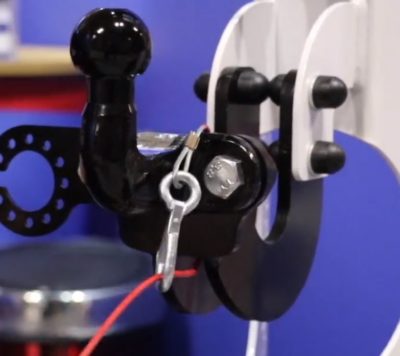
- A bolted tow ball with mounting point – Hook a carabiner style breakaway cable to the attached mounting point to get a secure fixing. If you have a spring clip breakaway cable DON’T attach it to the mounting point, but instead loop it around the tow ball and clip it back onto the cable.
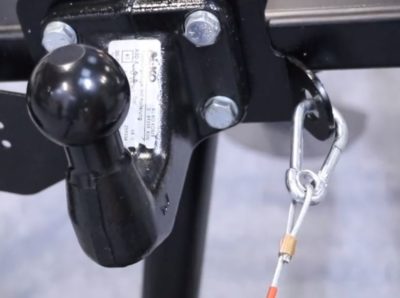
For more information and advice about hitching up and breakaway cables look at the National Caravan Council caravan towing guide.


Very good article and Tim’s explanations are precise and to the point. I understood the difference between the clip and the carabiner cables quite easily. Some years ago we had ‘help’ in attaching the caravan to the tow vehicle……..Only the helpful person rested the tow bar onto the tow ball….. Yep, it stayed on for around 100yds before the caravan and car parted company and the breakaway cable did its job. It was very hard to release the handbrake after it had been pulled on and then check that only the breakaway cable was the only thing that had been broken in the resulting drop of the tow bar to the ground….. Luckily the jockey wheel hit the ground and the tow bar was OK once a new breakaway cable was fitted. The result of this experience means that I double check everything is fitted correctly between the caravan and tow vehicle and will tug or pull everything to see if it is connected properly before moving off…… Its was not a nice experience and the noise as the breakaway cable pulled the brakes on and then broke is one I never want to hear again!!
When attaching a new cable I bought one with the carabiners one end a hook the other end. I was told to pinch the hook end attaching to the handbrake with mole grips. I’ve tried but it does not seem possible given the diameter of the steel on the hook. Any hints? ( I haven’t got a vice either;)
You could ask your local dealer to fit?
I have a Yeti with a detachable Westfalia towbar fitted by the dealer when I bought the car in 2010.
There is definitely no dedicated mounting point for the breakaway cable ( I have both checked the books given to me and physically checked the car) so reluctantly put the breakaway cable over the ball / neck which I agree is not really ideal but see no other option. As Tim works with DVSA and other agencies would he be able to advise is this legal and if stopped for a check would I be likely to get a prohibition or even fined & point on my licence
Hi Joe, if there is no designated mounting point available then the breakaway cable should be secured around the tow ball assembly- without any loops or knots in the cable and then clipped back to the cable.
Are all breakaway cables the same length and if not how do you know which to get
Breakaway cables do seem to come in different lengths. However, if you use the one that is manufactured by the caravan chassis manufacturer then you should find that they are the correct length.
Is it legal to replace a broken breakaway cable with a stout chain that has a greater resistance to snapping than the 2 tonne cable?
The breakaway cable is part of the chassis type approval system. The purpose of the breakaway cable is for it to snap when it needs to do so. A ‘stout’ chain with a greater resistance to breaking / snapping defeats the purpose of the cable.
A chain is permitted for trailers up to 750kgs where no braking system is fitted.
People who ask why the clip cannot be attached directly always get the same non-reply.
The answer is simple. The spring clip is just a relatively flimsy hook which will straighten out if pulled sharply by the weight of a caravan. Doubling the cable will considerably reduce the force, and almost certainly slow down its application, so the hook survives. The spring just stops the hook falling off the cable but doesn’t take any strain.
A Carabiner is an altogether tougher piece of kit which can take the full and sudden pull before breaking. The cable is fixed to a locating ring to make sure the pull is along the oval, the closing arm will interlock to make the oval a single loop of metal so it can’t just straighten.
Hope that gives a simple but comprehensive explanation. For more detail talk to a rock climber. They use all sorts of carabiners and have to understand how they work and can sometimes fail.
Thanks for your explanation Bob.
Hi Very Good helpful video but always a BUT with me ? with my recent acquired detachable Towbar on my car with clip end type breakaway cable on Caravan, its seems to me still not 100% safe looping around Towball head if say detachable Towball works loose & drops out of its socket which I have read has happened ! it would to me need a seperate fixed anchor point on towbar to pull Caravan handbrake on & to pull Caravan to a stop .
Hi Steve, you’re right, unfortunately there have been a number of detachable tow ball failures. It’s important that caravanners carefully inspect the tow bar assembly on their car to check if the fitter has not properly exposed the designated mounting point – as this can sometimes be the case!
Tim says if all else fails then you will on some tow bar fitments find that the securing bolts for the tow ball section housing can be used to secure a mounting point, using the bolt head as a fixing point. This should be checked with an approved fitter to check that this does not compromise the certification provided by the tow bar manufacturer.
We all agree that looping around the ball is not the safest of attachments, but in some situations it is the only viable option available.
Great, very clear and informative. I look forward to more videos.
Thanks Keith.
Brilliant. Very helpful, clear and instructive. Thank you
Thanks for the great feedback Pauline.
very clear and well explained,if you cant follow it you should not be towing
Very good and clear instructions.
But don’t forget when all you think is done,STOP and have a last check that everything else is connected property.
Does what it says on the tin
Having had spring clips in the past with no clip attachment when you loop the cable round the whole assembly it wears away the plastic coating and you then get metal to metal rubbing which wears the cable away, not a good thing to happen!
With the cable ‘clipped’ around the whole assembly the cable will achieve its actual potential of pulling the handbrake on. Where the spring clip was attached to a mounting point the ‘tug’ on the cable caused the clip to stretch, rather than to activate the handbrake – hence the move to change. In use there should be little movement of the cable assembly across the metal structures so wear should be minimal.
I had a near miss when my breakaway cable snapped upon pulling away from home with the caravan it seems like the hitch was not locked down properly the nearest caravan shop only had a breakaway chain available complete with strong clip as there is no mention of chains, and only wires my question is are breakaway chain assemblies legal and safe
A breakaway chain will normally be found on trailers that meet the 750kg category – often an in-braked trailer, although some manufacturers of these trailers now fit a braking system, with breakaway cable, to provide a safer operating system. When connecting a trailer to a tow ball assembly it’s important to check that the hitch head has properly engaged, before moving off. With the Al-Ko hitch head this is shown by a ‘green’ button indicator appearing in the unit.
Surely manufacturers of detachable tow bars should be able to come up with something better than just looping the breakaway cable over the ball? Possibly a welded mounting point on the neck or similar would be ideal.
Type Approval now requires the tow-bar assembly to have a designated mounting point. Tim Booth tells us that in roadside checks it has been identified that many tow bar fitting technicians have not provided sufficient ‘cut-out’ of the bumper bar cover to reveal that there is actually a designated mounting point provided. Have a good look under the car to see if this is the case here.
I agree with nigel above the cable should never be looped round the ball part as if this does become detached it will fail to put on the brake. Always put round a solid part of the tow hitch if you cannot then get your dealer to fit the appropriate length cable to do so, as they are available in differing length’s
Tim says the looping over the tow ball should always be considered as a last resort. On some occasions a longer cable can help – but be careful to make sure that the cable does not drag on the road surface when towing.
clears any confusion on the various ways of securing cable.
I agree with N Critchley, the cable needs to be attached to something other than the detachable part of the tow bar
The looping over the tow ball should always be considered as a last resort. Returning to the chassis of the car to secure the cable will always be the best solution – but not all tow bars provide this opportunity.
He says you cannot attach a spring clip to an attachment point but does not say why. If it will fit(as he shows it will) surely this gives a perfectly good attachment.
Hi Alan, Tim tells us that with the cable ‘clipped’ around the whole assembly the cable will achieve its actual potential of pulling the handbrake on. Where the spring clip was attached to a mounting point the ‘tug’ on the cable caused the clip to stretch, rather than to activate the handbrake – hence the move to change.
I have seen this advice many times in various places. But nobody explains why the spring clip should not be attached to a fixed mounting point.
In fact when I took the advice on a detachable towball and the towball detached there was nothing to pull the brake. Caravan written off but other damage thankfully.
Hi Judith, Tim tells us that with the cable ‘clipped’ around the whole assembly the cable will achieve its actual potential of pulling the handbrake on. Where the spring clip was attached to a mounting point the ‘tug’ on the cable caused the clip to stretch, rather than to activate the handbrake – hence the move to change.
Excellent video vital information!
Excellent instructions for not just new to towing but to seasoned towers. The industry and LAWS change regularly and we all have a duty ensuring we all tow legally.
Thanks to Caravan Guard for always keeping us well informed and shown the correct and incorrect ways.
Many thanks John
A very important point missing here. If the cable is lopped around a detachable towbar, which is defective, poorly maintained or incorrectly fitted, and the actual hitch becomes detached from it’s mounting. The tow ball will come away from the vehicle with the caravan and the caravan brakes will not be applied. There have recently been reports of poorly maintained detachable tow bars failing on prestige vehicles, indeed I have seen it happen.
Tim agrees and says this has happened on some rare occasions, hence the advice to seek to secure the cable by returning it to ‘the chassis of the car’.
Just come back to caravanning after 15year break. This article clarified how to fix to my detachable towbar.
How things have moved on
Unfortunately, despite stressing that a spring-clip cable should not be attached to a towing eye, no mention is made of WHY.
People need to know the reason and likely consequences of ‘doing it wrong’ ideally with a demonstration.
Hi Steve, Tim demonstrates the different ways of attaching a spring clip on different tow ball assemblies in the video. Where the spring clip was attached to a mounting point the ‘tug’ on the cable caused the clip to stretch, rather than to activate the handbrake – hence the move to change. With the cable ‘clipped’ around the whole tow bar assembly the cable will achieve its actual potential of pulling the handbrake on. Hope this clarifies matters.
Why cant a spring clip cable be attached to a tow bar fixing point? There doesn’t on looking seem to any major difference to a caribina clip?
Hi Andy, Tim tells us that where the spring clip was attached to a mounting point the ‘tug’ on the cable caused the clip to stretch, rather than to activate the handbrake – hence the move to change. With the cable ‘clipped’ around the whole tow bar assembly the cable will achieve its actual potential of pulling the handbrake on. Hope this explains it.
put the hand brake on before you take away your brake away
Not really because our towbar place where we have them from has told us to put the cable throw the bracket supplied then back to the cable not just put in hole of plate and that’s it. So I for one will be asking again and showing this video around to see which it is as they give all this information out which could be very wrong.
That seems correct. The breakaway cable should not be connected to the plate – but to a designated mounting point, or back to the cable.
Why was there no explanation of why a spring clip can’t be fitted to a dedicated breakaway mounting point. It looked as if was fine to do it that way.
Hi Kam, Tim tells us that where the spring clip was attached to a mounting point the ‘tug’ on the cable caused the clip to stretch, rather than to activate the handbrake – hence the move to change. With the cable ‘clipped’ around the whole tow bar assembly the cable will achieve its actual potential of pulling the handbrake on. Hope this is helpful?
It is good information for people new to caravanning & perhaps a reminder to those veterans of towing who may have got into bad habits, however I would have the article to have explained to the less informed why NOT to connect the spring type to the dedicated mounting point if there is one available
Hi Colin, Tim tells us that where the spring clip was attached to a mounting point the ‘tug’ on the cable caused the clip to stretch, rather than to activate the handbrake – hence the move to change. With the cable ‘clipped’ around the whole tow bar assembly the cable will achieve its actual potential of pulling the handbrake on. Hope this explains it?
Why is it wrong to attach a spring clip connector to a mounting point on the lowball mount, but OK to connect a carabina
Hi Terry, Tim tells us that where the spring clip was attached to a mounting point the ‘tug’ on the cable caused the clip to stretch, rather than to activate the handbrake – hence the move to change. With the cable ‘clipped’ around the whole tow bar assembly the cable will achieve its actual potential of pulling the handbrake on. Hope this explains it.
I use a detachable tow bar similar to the one in the first picture you are showing. You show the breakaway cable wrapped around the tow bar, but the manufacturer of mine tells me to attach the clip to the hole below the electrics bracket, the same sort of bracket you show here. Would you advise which is the correct method.
Trevor
Hi Trevor, The electric plate hanger is not sufficiently strong enough to secure to – unless it is an integral part of the tow bar structure.
I have learnt a lot about brakeaway cable from the video.
I have a detachable tow bar with a hitch eye but my caravan brake away cable has a spring clip. Do I ignore the tow bar eye and loop the cable back on it’s self around the tow bar as it is a spring clip?
That’s right Feliz. The electric plate hanger is not sufficiently strong enough to secure to. Also, Tim tells us that where the spring clip was attached to a mounting point the ‘tug’ on the cable caused the clip to stretch, rather than to activate the handbrake, so you are going to have to loop the cable back onto itself.
I disagree with not putting the spring type cable through the dedicated eye on the tow bar, as i Know off some one who’s Detachable tow bar came off with his cable around the ball and did not apply the hand brake, resulting in his van mounting the foot path into a wall before coming to rest? Surely had the cable been attached to the tow bar it would have applied the brakes.
If the tow bar has failed and the breakaway cable was attached to the mounting point, in this scenario it would have also been still attached tow bar assembly.
Very useful
Will clear any confusion for people new to caravanning
Extremely useful video.
Clear and precise,attach cable before letting brake off